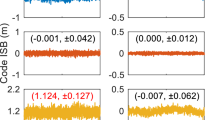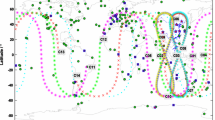Abstract
Care should be taken to minimize adverse impact of receiver differential code biases (DCBs) on global navigation satellite system (GNSS)-derived ionospheric parameters. It is therefore of importance to ascertain the intrinsic characteristics of receiver DCBs, preferably in the context of new-generation GNSS. In this contribution, we present a method that enables time-wise retrieval of between-receiver DCBs (BR-DCBs) from dual-frequency, code-only measurements collected by a pair of co-located receivers. This method is applicable to the US GPS as well as to a new set of GNSS constellations including the Chinese BeiDou, the European Galileo and the Japanese QZSS. With the use of this method, we determine the multi-GNSS BR-DCB time-wise estimates covering a time period of up to 2 years (January 2013–March 2015) with a 30-s time resolution for five receiver-pairs (four zero and one short baselines). For the BR-DCB time-wise estimates pertaining to an arbitrary receiver-pair and constellation, we demonstrate their promising intraday stability by means of statistical hypothesis testing. We also find that the BeiDou BR-DCB daily weighted average (DWA) estimates show a dependence on satellite type, in particular for receiver-pairs of mixed types. Finally, we demonstrate that long-term variability in BR-DCB DWA estimates can be closely associated with hardware temperature variations inside the receivers.
摘要
利用全球导航卫星系统(global navigation satellite system, GNSS)研究电离层需要克服接收机差分码偏差(differential code bias, DCB)的不利影响。在新一代GNSS应用环境下, 准确地了解接收机DCB的相关特性尤为重要。本文报告了一种相对接收机DCB(between-receiver DCB, BR-DCB)的单历元估计方法, 其适用于美国GPS(global positioning system), 中国“北斗”、欧盟“伽利略”和日本“准天顶卫星系统”(quasi-zenith satellite system, QZSS)。通过处理5对接收机(含4组零基线和1组短基线)的多GNSS观测数据(采集于2013年1月至2015年3月, 30 s采样间隔), 本文获取并分析了相应的BR-DCB单历元估值。主要结论包括: BR-DCB单历元估值在一天内不存在显著变化; 由不同类 “北斗”卫星观测值所计算的BR-DCB估值可能会存在差异; BR-DCB估值的长期变化与接收机硬件温度高度相关。





Similar content being viewed by others
References
Li Z, Yuan Y, Wang N et al (2015) SHPTS: towards a new method for generating precise global ionospheric TEC map based on spherical harmonic and generalized trigonometric series functions. J Geodesy 89:331–345
Liu L, Wan W, Chen Y et al (2011) Solar activity effects of the ionosphere: a brief review. Chin Sci Bull 56:1202–1211
Mannucci A, Wilson B, Yuan D et al (1998) Global mapping technique for GPS-derived ionospheric total electron content measurements. Radio Sci 33:565–582
Komjathy A, Wilson B, Pi X et al (2010) JPL/USC GAIM: on the impact of using COSMIC and ground-based GPS measurements to estimate ionospheric parameters. J Geophys Res 115:A02307
Hernández-Pajares M, Juan J, Sanz J et al (2009) The IGS VTEC maps: a reliable source of ionospheric information since 1998. J Geodesy 83:263–275
Gu S, Shi C, Lou Y et al (2015) Ionospheric effects in uncalibrated phase delay estimation and ambiguity-fixed PPP based on raw observable model. J Geodesy 89:447–457
Chen G, Zhao Q (2014) Near-field surface displacement and permanent deformation induced by the Alaska Mw 7.5 earthquake determined by high-rate real-time ambiguity-fixed PPP solutions. Chin Sci Bull 59:4781–4789
Hernández-Pajares M, Juan JM, Sanz J et al (2011) The ionosphere: effects, GPS modeling and the benefits for space geodetic techniques. J Geodesy 85:887–907
Liu Z, Skone S, Gao Y et al (2005) Ionospheric modeling using GPS data. GPS Solut 9:63–66
Yuan Y, Tscherning CC, Knudsen P et al (2008) The ionospheric eclipse factor method (IEFM) and its application to determining the ionospheric delay for GPS. J Geodesy 82:1–8
Yuan Y, Ou J (2002) Differential areas for differential stations (DADS): a new method of establishing grid ionospheric model. Chin Sci Bull 47:1033–1036
Spits J, Warnant R (2008) Total electron content monitoring using triple frequency GNSS data: a three-step approach. J Atmos Sol-Terr Phys 70:1885–1893
Le AQ (2006) Impact of Galileo on global ionosphere map estimation. J Navig 59:281–292
Tang W, Jin L, Xu K (2014) Performance analysis of ionosphere monitoring with BeiDou CORS observational data. J Navig 67:511–522
Yang Y, Li J, Xu J et al (2011) Contribution of the compass satellite navigation system to global PNT users. Chin Sci Bull 56:2813–2819
Lou Y, Liu Y, Shi C et al (2014) Precise orbit determination of BeiDou constellation based on BETS and MGEX network. Sci Rep. doi:10.1038/srep04692
Steigenberger P, Hugentobler U, Montenbruck O et al (2011) Precise orbit determination of GIOVE-B based on the CONGO network. J Geodesy 85:357–365
Hauschild A, Steigenberger P, Rodriguez-Solano C (2012) Signal, orbit and attitude analysis of Japan’s first QZSS satellite Michibiki. GPS Solut 16:127–133
Kawano I, Mokuno M, Kogure S et al (2004) Japanese experimental GPS augmentation using quasi-zenith satellite system (QZSS). In: Proceedings of the Institute of Navigation (ION) GNSS 2004, Long Beach
Sardon E, Rius A, Zarraoa N (1994) Estimation of the transmitter and receiver differential biases and the ionospheric total electron content from Global Positioning System observations. Radio Sci 29:577–586
Li Z, Yuan Y, Fan L et al (2014) Determination of the differential code bias for current BDS satellites. IEEE Trans Geosci Remote Sens 52:3968–3979
Sardón E, Zarraoa N (1997) Estimation of total electron content using GPS data: how stable are the differential satellite and receiver instrumental biases? Radio Sci 32:1899–1910
Li Z, Yuan Y, Li H et al (2012) Two-step method for the determination of the differential code biases of COMPASS satellites. J Geodesy 86:1059–1076
Montenbruck O, Hauschild A, Steigenberger P (2014) Differential code bias estimation using multi-GNSS observations and global ionosphere maps. Navig J Inst Navig 61:191–201
Ciraolo L, Azpilicueta F, Brunini C et al (2007) Calibration errors on experimental slant total electron content (TEC) determined with GPS. J Geodesy 81:111–120
Brunini C, Azpilicueta FJ (2009) Accuracy assessment of the GPS-based slant total electron content. J Geodesy 83:773–785
Coster A, Williams J, Weatherwax A et al (2013) Accuracy of GPS total electron content: GPS receiver bias temperature dependence. Radio Sci 48:190–196
Zhang D, Shi H, Jin Y et al (2014) The variation of the estimated GPS instrumental bias and its possible connection with ionospheric variability. Sci China Technol Sci 57:67–79
Zhang D, Zhang W, Li Q et al (2010) Accuracy analysis of the GPS instrumental bias estimated from observations in middle and low latitudes. Ann Geophys 28:1571–1580
Zhang W, Zhang D, Xiao Z (2009) The influence of geomagnetic storms on the estimation of GPS instrumental biases. Ann Geophys 27:1613–1623
Zhong J, Lei J, Dou X et al (2015) Is the long-term variation of the estimated GPS differential code biases associated with ionospheric variability? GPS Solut. doi:10.1007/s10291-015-0437-5
Zhang B, Ou J, Yuan Y et al (2012) Extraction of line-of-sight ionospheric observables from GPS data using precise point positioning. Sci China Earth Sci 55:1919–1928
Stephens P, Komjathy A, Wilson B et al (2011) New leveling and bias estimation algorithms for processing COSMIC/FORMOSAT-3 data for slant total electron content measurements. Radio Sci. doi:10.1029/2010RS004588
Nadarajah N, Teunissen P, Raziq N (2013) BeiDou inter-satellite-type bias evaluation and calibration for mixed receiver attitude determination. Sensors 13:9435–9463
Freedman DA (2009) Statistical models: theory and practice. Cambridge University Press, London
Acknowledgments
We would like to express our gratitude to Dr. Oliver Montenbruck and Dr. Jean-Marie Sleewaegen for their thoughtful suggestions and extensive discussions. Special thanks go to Dr. Nandakumaran Nadarajah and Mr. Matt Carver for collecting the multi-GNSS experimental data and to Bureau of Meteorology (Australia) for providing the online climate data. This work has been executed in the framework of the Positioning Program Project 1.19 “Multi-GNSS PPP-RTK Network Processing” of the Cooperative Research Centre for Spatial Information (CRC-SI). This work was also partially funded by the Chinese Academy of Sciences (CAS) and the Royal Netherlands Academy of Arts and Sciences (KNAW) joint research project “Compass, Galileo and GPS for improved ionosphere modelling.” The second author is the recipient of an Australian Research Council (ARC) Federation Fellowship (NO. FF0883188). All this support is gratefully acknowledged.
Conflict of interest
The authors declare that they have no conflict of interest.
Author information
Authors and Affiliations
Corresponding author
Electronic supplementary material
Below is the link to the electronic supplementary material.
About this article
Cite this article
Zhang, B., Teunissen, P.J.G. Characterization of multi-GNSS between-receiver differential code biases using zero and short baselines. Sci. Bull. 60, 1840–1849 (2015). https://doi.org/10.1007/s11434-015-0911-z
Received:
Accepted:
Published:
Issue Date:
DOI: https://doi.org/10.1007/s11434-015-0911-z




